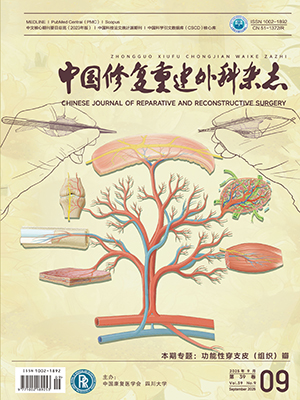| 1. |
Giannoudis PV, Pape HC. Damage control orthopaedics in unstable pelvic ring injuries. Injury, 2004, 35(7): 671-677.
|
| 2. |
Grotz MR, Allami MK, Harwood P, et al. Open pelvic fractures: epidemiology, current concepts of management and outcome. Injury, 2005, 36(1): 1-13.
|
| 3. |
Mohanty K, Musso D, Powell JN, et al. Emergent management of pelvic ring injuries: an update. Can J Surg, 2005, 48(1): 49-56.
|
| 4. |
Basta AM, Blackmore CC, Wessells H. Predicting urethral injury from pelvic fracture patterns in male patients with blunt trauma. J Urol, 2007, 177(2): 571-575.
|
| 5. |
Gänsslen A, Hildebrand F, Heidari N, et al. Pelvic ring injuries in children. Part I:Epidemiology and primary evaluation. A review of the literature. Acta Chir Orthop Traumatol Cech, 2012, 79(6): 493-498.
|
| 6. |
Pereira GJC, Damasceno ER, Dinhane DI, et al. Epidemiology of pelvic ring fractures and injuries. Rev Bras Ortop, 2017, 52(3): 260-269.
|
| 7. |
Routt ML, Simonian PT. Closed reduction and percutaneous skeletal fixation of sacral fractures. Clin Orthop Relat Res, 1996, (329): 121-128.
|
| 8. |
Thaunat M, Laude F, Paillard P, et al. Transcondylar traction as a closed reduction technique in vertically unstable pelvic ring disruption. Int Orthop, 2008, 32(1): 7-12.
|
| 9. |
陈华, 齐红哲, 朱正国, 等. 骨盆外架辅助复位联合通道螺钉固定治疗TileC1型骨盆骨折. 中华创伤杂志, 2018, 34(10): 919-924.
|
| 10. |
Boudissa M, Roudet A, Fumat V, et al. Part 1: Outcome of posterior pelvic ring injuries and associated prognostic factors—A five-year retrospective study of one hundred and sixty five operated cases with closed reduction and percutaneous fixation. Int Orthop, 2020, 44(6): 1209-1215.
|
| 11. |
王刚, 张月雷, 章乐成, 等. 骨科机器人联合骨盆解锁复位架辅助下经皮螺钉固定治疗骨盆骨折. 中华创伤骨科杂志, 2020, 22(6): 475-481.
|
| 12. |
陈华, 白雪东, 易成腊, 等. 中国骨盆骨折微创手术治疗指南 (2021). 中华创伤骨科杂志, 2021, 23(1): 4-14.
|
| 13. |
陈华, 唐佩福. 骨盆髋臼骨折微创治疗. 郑州: 河南科学技术出版社, 2016: 63-74, 119-140.
|
| 14. |
Chen H, Zhang Q, Wu Y, et al. Achieve closed reduction of irreducible, unilateral vertically displaced pelvic ring disruption with an unlocking closed reduction technique. Orthop Surg, 2021, 13(3): 942-948.
|
| 15. |
Pape HC, Tornetta P, Tarkin I, et al. Timing of fracture fixation in multitrauma patients: the role of early total care and damage control surgery. J Am Acad Orthop Surg, 2009, 17(9): 541-549.
|
| 16. |
Fitzgerald CA, Morse BC, Dente CJ. Pelvic ring fractures: has mortality improved following the implementation of damage control resuscitation? Am J Surg, 2014, 208(6): 1083-1090.
|
| 17. |
胡居正, 石展英, 王仁崇, 等. Starr复位架联合 “O” 型臂导航系统治疗骨盆骨折的近期疗效. 中华骨科杂志, 2019, 39(13): 817-825.
|
| 18. |
唐经励, 刘搏宇, 胡居正, 等. Starr架辅助复位INFIX与前柱螺钉内固定治疗不稳定骨盆骨折临床比较分析. 创伤外科杂志, 2019, 21(1): 9-13.
|
| 19. |
李悦, 李辉, 李天宇, 等. 骨盆复位架在骨盆骨折闭合复位和微创固定的初步临床应用. 创伤外科杂志, 2021, 23(1): 5-9.
|
| 20. |
杨成亮, 杨晓东, 刘佳, 等. 骨盆解锁复位架辅助微创治疗TileC2、C3型骨盆骨折. 中华骨科杂志, 2021, 41(19): 1380-1386.
|
| 21. |
杨成志, 黄站珠, 唐经励, 等. 骨科手术机器人与 “O” 型臂X线导航辅助骨盆骨折经皮内固定术的比较. 中华骨科杂志, 2021, 41(19): 1387-1395.
|
| 22. |
杨家赵, 谢凯, 李黎, 等. 骨盆支架辅助复位联合通道螺钉固定治疗骨盆骨折. 临床骨科杂志, 2021, 24(5): 699-703.
|
| 23. |
杨家赵, 方诗元. 智能监视系统辅助骨盆复位架复位骨盆骨折1例. 临床骨科杂志, 2021, 24(4): 565.
|
| 24. |
Luo Y, Chen H, He L, et al. Displaced posterior pelvic ring fractures treated with an unlocking closed reduction technique: Prognostic factors associated with closed reduction failure, reduction quality, and fixation failure. Injury, 2022. doi: 10.1016/j.injury.2022.01.001.
|
| 25. |
麦奇光, 陈煜辉, 朱振华, 等. 骨盆解锁复位架辅助复位固定治疗陈旧性DenisⅠ、Ⅱ型骶骨骨折合并骶丛损伤. 中华骨科杂志, 2022, 42(10): 652-660.
|
| 26. |
林森财, 伍洪. 西门子小C形臂原理与维修. 现代科学仪器, 2002, (6): 60-61.
|
| 27. |
Lefaivre KA, Starr AJ, Barker BP, et al. Early experience with reduction of displaced disruption of the pelvic ring using a pelvic reduction frame. J Bone Joint Surg (Br), 2009, 91(9): 1201-1207.
|




